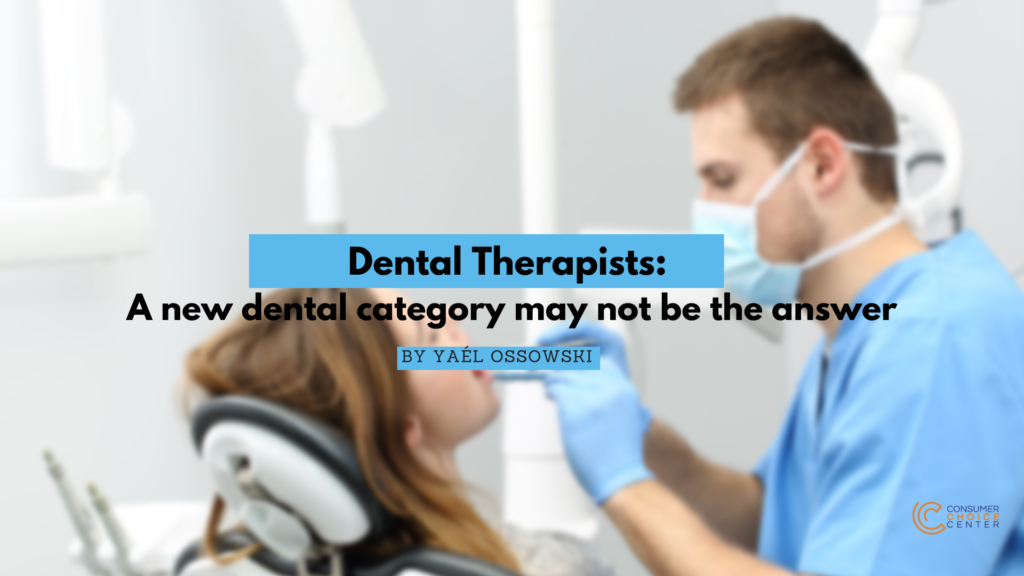When it comes to U.S. health policy and healthcare reform, a significant area that has received little attention is that of dental care. Through the Affordable Care Act and subsequent reforms, policymakers have focused on making general healthcare more accessible and affordable, with disparate results. Despite that focus on access and affordability, there has been little change or reform in dental care and dental insurance.
Though 80% of the population has access to dental benefits, nearly 35% of American adults didn’t visit a dentist in 2019.
For patients, we know that the most cited reason for not visiting a dentist is cost, owing to either inadequate coverage or lack of traditional dental benefit plans. While children under 18 and seniors over 65 can take advantage of various government plans and subsidies, the majority of American adults receive dental benefits from their employer.
In this policy note, we would like to address the state of dental insurance, which, in our estimation, serves to inflate the cost of dental care and complicate oral health for millions of Americans, and offer policy recommendations to help improve overall dental care.
As such, we promote several reforms that would help lower costs for dental patients, reduce bureaucracy, and increase transparency, competition, and consumer choice.
We favor a consumer-friendly model of dental care that is more direct-to-consumer, more transparent on costs, promotes flexibility, and moves patients away from having to rely on employers for dental coverage.
Here we present our recommendations to lawmakers and regulators in key jurisdictions, hoping to better inform future healthcare and dental care legislation.
CURRENT ISSUES
The Middle Man
The complexity of dental insurance is a well-established trope among health reformists and patient advocates. Unlike most healthcare plans, dental plans have low caps on the number of benefits they will pay out, anywhere between $1000-$1,500 a year. Premiums vary but average $30-$50 per month depending on the plan and the number of people covered.
If we recall, the purpose of insurance is to transfer risk to reduce costs while maintaining protection. Consumers pay a monthly premium to contribute to a fund held by an insurance company accessed when needed, especially in emergencies. That balancing of financial risk is how insurers make money, hoping to pay out less than they take in from premiums, while consumers benefit by not having to bear the full cost when unexpected expenses occur.
In the last two decades in the healthcare sector, including dental care, we’ve witnessed what is known in economics as “transaction decoupling,” where bundled services obfuscate sunken costs and decrease price sensitivity. Simply put, because we only pay for premiums through employers, we tend to ignore the real costs of health care.
The broad trend of using insurance to cover all aspects of healthcare, rather than emergencies, is a significant factor in the inflation of the price of care, which economists have dubbed the “social consequences problem” Encouraging competition to traditional dental insurance, while promoting simple regulations to promote financial transparency, will serve to empower consumers and lower the costs of care.
The Role of Employers
The most common private dental plans are managed through dental Preferred Provider Organizations (PPOs), Health Maintenance Organizations (HMOs), dental indemnity plans, or discount dental plans offered as subscriptions.
At present, 93% of privately insured dental patients receive coverage from their employer, mostly through PPOs, meaning employers select a private dental insurer and manage the plan in order to receive a bulk discount.
This means that the majority of patients and consumers do not directly purchase or control their dental insurance, and thus rely on their employers to make good choices for them. And this does not even take into consideration those who may be between jobs or newly unemployed. Because employer plans are the focus, there is little incentive to innovate direct-to-consumer options and offer competition to incumbents.
When employers contract with dental insurers, the choices are not as diverse as we would assume.
Competition
In California, where we have the best data available, nearly half of all dental insurance is provided by just two companies, Delta Dental and MetLife. Throughout the country, the other two major insurers are Cigna and Anthem, leading to major market concentration and little competition. This reduced competition, sustained by administrative and regulatory burdens, serves to increase costs for patients and reduce payments offered to dentists.
A 2020 quantitative study finds disparities between dental health insurers and dental providers, demonstrating that reimbursement rates have declined significantly for dentists while premiums have gone up, which only benefits insurance companies at the expense of both patients and dentists.
The Competitive Health Insurance Reform Act of 2020, signed by President Trump, levels the playing field between health and dental insurers and all other industries, ensuring consumers are protected from price-fixing by the limited number of insurers. A slew of state reforms have been passed on similar issues, and have thus muddied the federal and state jurisdictions for regulation.
Innovation
There are also examples of dental savings plans, which pool discounts for patients, and allow flexible choices between dentists.
The static nature of the traditional dental insurance industry, along with the complexity of reimbursement for patients, waiting periods for care, caps that are too low to cover against financially catastrophic events, and relatively low levels of transparency around insurance costs, make dental care and dental insurance ripe for disruption and reform.
RECOMMENDATIONS
Direct Primary Care and Membership Programs for Dental Services
Assignment of Benefits Laws
Medical Loss Ratio
Network Leasing
Financial Transparency
Rethinking insurance
READ THE FULL POLICY NOTE HERE
AUTHORS:




